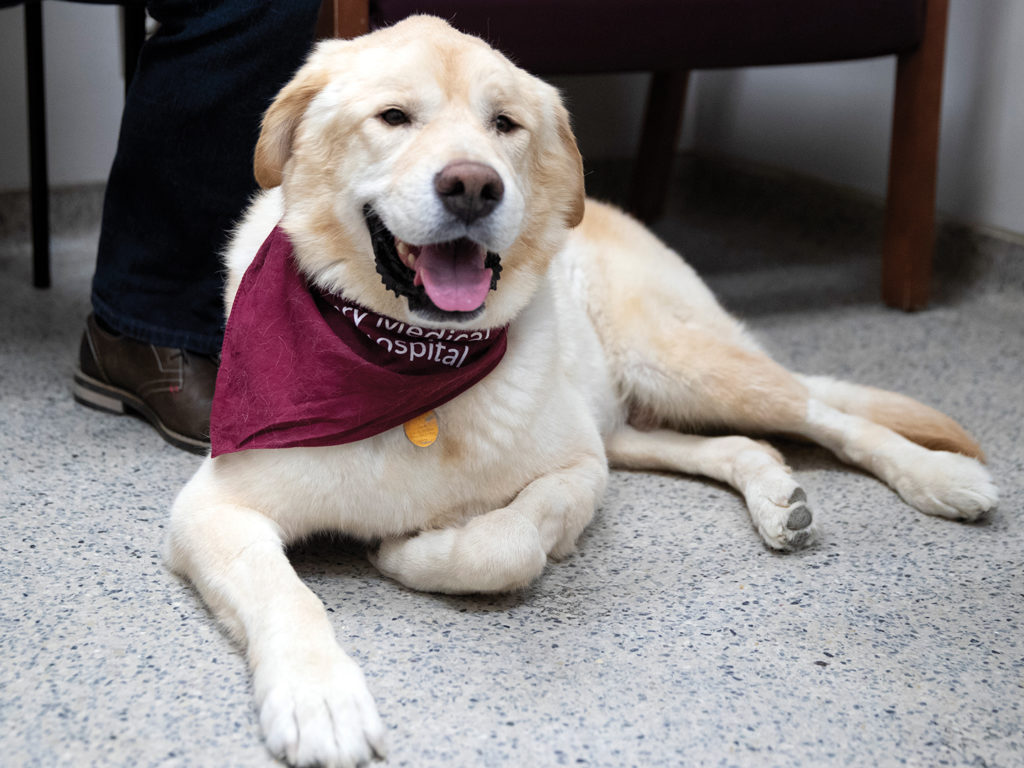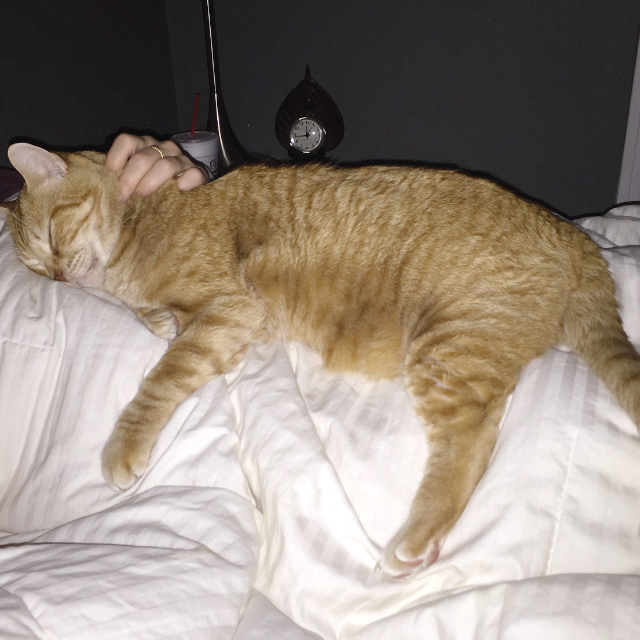Texas A&M Veterinarians Use Revolutionary Technique To Transform Landscape Of Pituitary Gland Surgery
Story by Dorian Martin

Note: This procedure is not available for all patients. Please contact the Texas A&M Veterinary Medical Teaching Hospital at 979.845.2351 with any questions.
It’s been over a year since T, a 9-year-old English Labrador, underwent life-saving surgery to remove his pituitary gland at Texas A&M University’s Veterinary Medical Teaching Hospital (VMTH), and according to owner Brian Prachyl, the improvement in the dog’s quality of life has been amazing.
“Previously, T could barely walk when we’d take him out to the backyard. He would be so exhausted when he got back to the house,” Prachyl said. “Now, he’s normal as far as his health and energy level, and he can run again at full speed. Every day is a good day.”
This innovative surgery provides an important veterinary option for animals like T when the pituitary gland, which plays a critical health role, malfunctions.
“This surgery provides us with the ability to help patients who are not responding to our classic medical therapies,” said Dr. Joseph Mankin, College of Veterinary Medicine & Biomedical Sciences (CVMBS) clinical associate professor in neurology, who conducted the surgery in tandem with doctors from Washington State University’s (WSU) Veterinary Teaching Hospital. “It’s an option that we didn’t have until recently and it’s not available in many places in the country. Hopefully, this will allow us to provide a service to a lot of those patients who need more extensive and more advanced therapies to get them back to a normal and good quality of life.”
T In Trouble
T’s health issues began at the age of 6, when he started having regular skin infections and constant hunger and thirst. Tests confirmed the diagnosis of Cushing’s disease, which causes a dog’s body to produce too much cortisol, a hormone related to stress.
Soon the dog’s condition declined further as he began suffering extreme fatigue, a weakened immune system, muscle weakness, skin lesions, hair loss, and deep-tissue staph infection. All of these symptoms were linked to a growing tumor on the dog’s pituitary gland.
“The pituitary gland helps regulate the hormones that influence the physical function in a dog or cat,” Mankin said. “If a tumor grows in that area, it can cause the pituitary gland to produce hormones that can result in endocrine diseases that medicine will not solve.”
“This surgery provides us with the ability to help patients who are not responding to our classic medical therapies. Hopefully, this will allow us to provide a service to a lot of those patients who need more extensive and more advanced therapies to get them back to a normal and good quality of life.”
Dr. Joseph Mankin
These endocrine diseases include Cushing’s disease in dogs and diabetes in cats. This growth also can result in a tumor that causes pressure to build in the animal’s brain, leading to the neurologic abnormalities that T was displaying. Previously, these types of issues were treated through medication to manage the disease’s symptoms, but the drugs did not address the underlying problem.
When T stopped responding to medications for Cushing’s disease, the Prachyls made an appointment with the VMTH, however, on the day before their journey to College Station, the dog’s condition rapidly deteriorated.
Minutes after the VMTH’s initial consult, T was sedated and on the surgery table. A veterinary surgeon spent three hours removing fluid build-up from behind the dog’s eye socket that was caused by the swelling pituitary tumor.
While T lost all sight in that eye, his overall health rebounded, thanks to treatment using an older class of medication designed to turn off the adrenal gland. However, when it was announced that the drug, which was the only medication that T responded favorably to, would be taken off the market, the Prachyls began to consider leading-edge surgery to remove T’s pituitary gland.
“The goal of the surgery is to go in through the roof of the mouth to the base of the skull and use some very small instruments to do some delicate surgical techniques to remove the actual pituitary gland,” Mankin said. “This allows us to have resolution concerning the excessive hormone production.
“The main risk with this surgery is for bleeding. The pituitary gland is surrounded by vital arteries, and if they are damaged the consequences can be significant,” he said.
The Prachyls decided that the innovative surgery was worth the risk.
The operation took six painstaking hours to remove the dog’s pituitary gland tumor, which had tripled in size and was pressing on his brain, but was ultimately successful.
In the period since the surgery, the Prachyls have been able to wean the dog off of medication for the tumor. The only reminder of his life-threatening health issues is that he’s growing thick puppy fur as an adult dog, which was caused by the increasing pressure that the tumor placed on T’s brain.
Haz-ard Duty

Haz-mat, an orange shorthair domestic cat, faced a similar health journey to T’s, leading the VMTH to become one of only a handful of veterinary facilities in the United States to successfully perform pituitary gland removal surgery from the brains of both a dog and a cat.
When a veterinarian initially diagnosed the cat with diabetes in 2017, owner Melody Flowers worried Haz-mat had additional health issues; he was having trouble regulating his appetite, which led to significant weight gain and increased thirst and urination.
Flowers researched these symptoms and sought a referral to the VMTH, where Dr. Millie Grimes, a veterinary resident, agreed with Flowers’ assessment and suggested the possibility of pituitary gland surgery.
However, two years passed before the VMTH was prepared to work with WSU surgeons to do the surgery.
“We worked closely with the team from WSU to ensure that we were approaching these cases in the best and safest possible way, with their assistance on patient selection, the surgery itself, and the postoperative care,” Mankin said.
During this period, Haz-mat developed obstructed breathing and hip pain. In addition, his diabetes required 30 units of insulin daily, even though the cat’s blood sugar level could not be controlled.
Worried about her pet, Flowers opted for the surgery when it became available. The surgery, which also was performed by Mankin during the same timeframe as T’s, went well and Haz-mat made a complete recovery.
Shortly after surgery, the cat’s need for insulin decreased from 30 units daily to four units daily; this resulted in a $450 monthly savings in medication costs. Now, Haz-mat is totally off insulin and is no longer diabetic; he only has to take easy-to-administer maintenance medications that replace the function of the pituitary gland.
“The surgery has been a game-changer for both of us. He is back to enjoying his food and life. He’s coasting right now,” the Waco resident said. “Now I can live my life without needing to be chained to Haz-mat’s medication schedule.”
“Dr. Grimes said this surgery would increase Haz-mat’s quality of life and that’s been completely 100% true,” Flowers said. “I cannot be more complimentary of the VTMH in general and the people who work there. They are really good people and quintessential professionals who are kind and thoughtful.”
###
Note: This story originally appeared in the Spring 2021 edition of CVMBS Today.
For more information about the Texas A&M College of Veterinary Medicine & Biomedical Sciences, please visit our website at vetmed.tamu.edu or join us on Facebook, Instagram, and Twitter.
Contact Information: Jennifer Gauntt, Director of CVMBS Communications, Texas A&M College of Veterinary Medicine & Biomedical Sciences; jgauntt@cvm.tamu.edu; 979-862-4216


